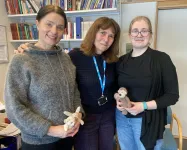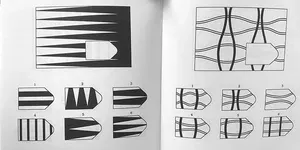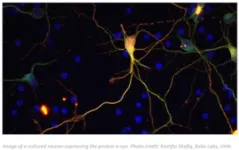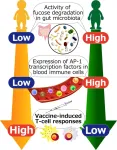(Press-News.org) Children learn to understand language and to speak largely independently of cognitive functions like spatial awareness, working (short-term) memory and perception (interpreting and organizing sensory impressions), according to established theory and tradition within linguistics.
Professor Mila Vulchanova at the Norwegian University of Science and Technology (NTNU) heads the university's language laboratory and studies language learning. Her findings over several years have challenged this linguistic assumption and demonstrated clear associations between language development and cognitive skills.
Found new links
Vulchanova’s latest research is based on data from the largest cohort study conducted in Norway. The Mother, Father and Child Cohort Study (MoBa), under the auspices of the Norwegian Institute of Public Health, is one of the world's largest health surveys, with data from 114 500 children, 95 000 mothers and 75 000 fathers.
Mila Vulchanova and research colleagues from NTNU, the University of Oslo, Statped and the University of Melbourne have now catalogued new links between language development and cognitive skills.
Cognitive skills are a collective term for our ability to concentrate, pay attention, remember, our sense perception, logical reasoning and problem solving.
Non-verbal tests reveal a lot about children's language development
Language comprehension tests are naturally used to investigate whether children have language development challenges. Vulchanova's research shows that non-verbal tests are also very important for cataloguing language difficulties, what types of language challenges the child has, and in particular the severity of the language difficulties.
Researchers analysed data from more than 500 8-year-old children in the research project.
“We analysed extensive data on the language and cognitive status of children with language difficulties and compared them with children who have typical language development. The analyses show that the severity of the language difficulties can also be predicted based on cognitive markers. These are discoveries that pave new paths for research in this field,” says Vulchanova.
Cognitive markers include logical reasoning, such as recognizing similarities between concepts or discovering connections between graphic patterns. Cognitive markers are mapped based on both verbal and non-verbal tests.
How the balance between verbal and non-verbal cognitive skills affects language skills is a field that has been relatively unexplored in the past.
Which cognitive measurements and methods best predict the severity of language disorders in children is not yet well known, either.
The new research findings are contributing to finding answers to these questions.
Early and correct assessment is important
An early assessment of a child's language difficulties and correctly identifying the severity of the language difficulties is key. The right training and support can then be implemented, for example via a speech therapist, and contribute to better language development.
“Our findings support the importance of measuring both verbal and non-verbal cognitive skills. In this way, we can identify which dimensions are affected and require special attention in children with language difficulties," Vulchanova said.
“Our findings also point to the potential for training cognitive skills as a strategy to support language skills,” she said.
Different testing methods
One of the six testing methods used to assess the 8-year-olds is called block design and involves recognizing patterns and seeing which patterns fit into the context.
Another test assesses the child’s ability to recognize similarities and serves as a bridge between verbal and non-verbal skills. A sample question could be, "What is the connection between a sea and a river?" Here the child needs to understand what the words mean and also connect that they both involve water.
“We identify specific verbal and non-verbal cognitive tests that differentiate between typical children and children with language difficulties, as well as the severity of language difficulties,” says Vulchanova.
“What distinguished the group with mild language impairment from the group with typical language development were the scores on the pattern recognition test (block design) and the similarity test (the similarity between, for example, sea and river), as well as performance on logical reasoning, vocabulary, understanding daily sequences and tasks and non-word repetition,” she says.
In the non-word test, the children have to read short words and sort them as being either real words or non-words.
“All the verbal cognitive results could predict severe language problems versus typical language development,” says Vulchanova.
Providing training to others
Three people are gathered in Vulchanova's office to plan training sessions in language testing. They plan to hold courses for educational professionals, including kindergarten staff, people in the schools' PPT service, speech therapists and kindergarten pedagogues and teach them methods that they can use to survey the children's language skills.
The course holders are Vulchanova, Berit Sivertsen, educational leader at Berg kindergarten in Trondheim and Ellen Saxlund, a lecturer at a secondary school in Bærum. Both Sivertsen and Saxlund have taken master's degrees at NTNU's Department of Language and Literature and have had Vulchanova as their supervisor.
The researchers use various objects in their course, such as a picture book, toys and stuffed animals – including a little monkey. All these items are included in the new Reynell test that Vulchanova and colleagues have adapted and standardized for the Norwegian language.
Stuffed animals are part of testing
“We perform different actions with the monkey, like making it jump, and then we ask the child to tell us what it’s doing. We’re looking for the child to identify the action and use the correct verb,” says Saxlund.
Sivertsen pulls out a rabbit from the bag of testing materials.
“We also test children’s understanding of prepositions by asking them to place the rabbit on top of, next to or below another object,” she says.
Mila Vulchanova takes out a picture book with pictures of figures performing various actions, including a rabbit brushing a monkey. Here the children have to point out the correct pictures based on questions about what the figures are doing and who is doing what. The use of verbs in active and passive voice is key for this test.
Vulchanova stresses that language proficiency is linked to all cognitive abilities.
In their analysis, the researchers summarize:
Our findings support the importance of measuring both verbal and non-verbal cognitive skills in order to identify the most vulnerable dimensions in children with language difficulties, but also with regard to diagnosis.
The findings also point to the potential for targeting underlying cognitive skills as a strategy to support language skills.
We suggest that future interventional studies focus on the effect of non-verbal cognitive skills on language development in children with language difficulties.
Reference: Intl J Lang Comm Disor – 2023 – Jin – The association of cognitive abilities with language disorder in 8‐year‐olds (1).
END
Children’s language development doesn’t just happen through words
Language learning and cognitive skills are linked
2023-04-20
ELSE PRESS RELEASES FROM THIS DATE:
Researchers identify a potential new therapeutic target in Parkinson’s disease
2023-04-20
TORONTO - In a study published in Nature Communications, a team led by Krembil Brain Institute Senior Scientists, Drs. Lorraine Kalia and Suneil Kalia, and University of Toronto (U of T) Professor, Dr. Philip M. Kim, identified a protein-protein interaction that contributes to Parkinson’s disease.
In the disease, a protein called α-synuclein (a-syn) accumulates in the brain and leads to cell death. Much research is currently focused on clearing a-syn with antibodies or using small molecules to prevent a-syn from aggregating. In this study, the researchers took an alternate approach by looking for protein-protein interactions that may be promoting ...
Dr. Natalya Chernichenko named site chief of otolaryngology at NewYork-Presbyterian Brooklyn Methodist Hospital
2023-04-20
Dr. Natalya Chernichenko, a leading otolaryngologist who specializes in tumors of the head and neck, has been named site chief of otolaryngology at NewYork-Presbyterian Brooklyn Methodist Hospital, effective May 1. Dr. Chernichenko was also recruited to Weill Cornell Medicine as an assistant professor of clinical otolaryngology and vice chair in the Department of Otolaryngology—Head and Neck Surgery.
In her new role, Dr. Chernichenko will lead a skilled team of specialists and surgeons providing comprehensive otolaryngology care, also known as ear, nose and throat, or ENT care, and further develop the hospital’s head and neck surgical oncology ...
FAU gets $6 million to increase mental health counselors in Florida schools
2023-04-20
Youth mental and emotional health is a matter of high priority in Florida. A 2019 Florida Department of Health survey showed that 12.7 percent of Florida high schoolers (grades 9 to 12) had carried a weapon; 21.2 percent were involved in a physical altercation; 24.2 percent reported having been teased about their size, weight or physical appearance; and 11.3 percent and 14.9 percent were bullied electronically or on school property, respectively.
In this same survey, 15.6 percent of Florida high school students reported they had seriously considered attempting suicide, and 33.7 percent acknowledged feeling sad or hopeless for two or more weeks in a row. Alarmingly, the 2019 survey ...
University of Cincinnati research examines the impact of maternal stress during pregnancy on child’s health
2023-04-20
New research out of the University of Cincinnati examines the impact that maternal stress during pregnancy has on the neurodevelopment of babies.
The study was published in the journal Molecular Psychiatry.
Prenatal maternal stress life events are associated with adverse neurodevelopmental outcomes in offspring. Biological mechanisms underlying these associations are largely unknown, but a chemical reaction in the body in which a small molecule known as a methyl group gets added to DNA, called DNA methylation, likely plays a role, according to researchers. These findings could provide new insights into how the fetal environment potentially influences ...
TIBI Director and CEO Ali Khademhosseini receives Technology Innovation and Development award from the Society for Biomaterials
2023-04-20
(LOS ANGELES) – April 20, 2023 - Dr. Ali Khademhosseini has been awarded the 2023 Technology Innovation and Development Award from the Society of Biomaterials (SFB). The award honors those whose research, scientific innovations, and leadership are used to develop novel products or technologies to benefit patients.
Dr. Khademhosseini is the founding Director and CEO of the Terasaki Institute for Biomedical Innovation (TIBI), which incorporates a variety of interdisciplinary research platforms and uses patient-derived cells for micro- and ...
Novel antibiotic-delivery system to target aggressive gum infections in adolescents
2023-04-20
Aggressive periodontitis is a severe type of gum infection that causes the destruction of ligament and bone and can lead to tooth loss in otherwise healthy individuals. Traditional treatment typically involves deep cleaning and antibiotics.
Lehigh University researcher Angela Brown and her team were recently awarded a grant from the National Institutes of Health (NIH) to pursue a novel treatment alternative.
Brown, an associate professor of chemical and biomolecular engineering in Lehigh’s P.C. Rossin College of Engineering and Applied Science, received an Exploratory/Development Research ...
Is Deep Learning a necessary ingredient for Artificial Intelligence?
2023-04-20
The earliest artificial neural network, the Perceptron, was introduced approximately 65 years ago and consisted of just one layer. However, to address solutions for more complex classification tasks, more advanced neural network architectures consisting of numerous feedforward (consecutive) layers were later introduced. This is the essential component of the current implementation of deep learning algorithms. It improves the performance of analytical and physical tasks without human intervention, and lies behind everyday automation products such as the emerging technologies for self-driving cars and autonomous chat bots.
The key question driving new research published today in Scientific ...
Study gives insight into cause of severe inflammatory bowel disease
2023-04-20
Cedars-Sinai investigators have identified a genetic variant that increases people’s risk of developing perianal Crohn’s disease, the most debilitating manifestation of Crohn’s disease.
The variant generates changes to DNA that lead to a loss of protein function, which in turn, alters how the body recognizes and handles bacteria, making it less effective at fighting infections.
The discovery is published in the peer-reviewed journal GUT.
“Fistulizing perianal Crohn’s disease ...
Gut bacteria could be behind weaker immune responses to COVID-19 vaccine
2023-04-20
Gut bacteria that break down a sugar called fucose could be dampening our immune response to the COVID-19 mRNA vaccine, according to a study led by researchers from the Okinawa Institute of Science and Technology (OIST).
The scientists report that increased fucose digestion by bacteria in the gut before vaccination was associated with lower numbers of T-cells activated by vaccination. T-cells are an important type of blood immune cell that are activated by a specific strain of bacteria or virus, and then multiply to fight the infection.
The findings, published ...
Swedish quantum computer applied to chemistry for the first time
2023-04-20
There are high expectations that quantum computers may deliver revolutionary new possibilities for simulating chemical processes. This could have a major impact on everything from the development of new pharmaceuticals to new materials. Researchers at Chalmers University have now, for the first time in Sweden, used a quantum computer to undertake calculations within a real-life case in chemistry.
“Quantum computers could in theory be used to handle cases where electrons and atomic nuclei move in more complicated ways. If we can learn to utilise their full potential, we should be able to advance the boundaries of what is possible to calculate and understand,” says Martin Rahm, ...
LAST 30 PRESS RELEASES:
Numbers in our sights affect how we perceive space
SIMJ announces global collaborative book project in commemoration of its 75th anniversary
Air pollution exposure and birth weight
Obstructive sleep apnea risk and mental health conditions among older adults
How talking slows eye movements behind the wheel
The Ceramic Society of Japan’s Oxoate Ceramics Research Association launches new international book project
Heart-brain connection: international study reveals the role of the vagus nerve in keeping the heart young
Researchers identify Rb1 as a predictive biomarker for a new therapeutic strategy in some breast cancers
Survey reveals ethical gaps slowing AI adoption in pediatric surgery
Stimulant ADHD medications work differently than thought
AI overestimates how smart people are, according to HSE economists
HSE researchers create genome-wide map of quadruplexes
Scientists boost cell "powerhouses" to burn more calories
Automatic label checking: The missing step in making reliable medical AI
Low daily alcohol intake linked to 50% heightened mouth cancer risk in India
American Meteorological Society announces Rick Spinrad as 2026 President-Elect
Biomass-based carbon capture spotlighted in newly released global climate webinar recording
Illuminating invisible nano pollutants: advanced bioimaging tracks the full journey of emerging nanoscale contaminants in living systems
How does age affect recovery from spinal cord injury?
Novel AI tool offers prognosis for patients with head and neck cancer
Fathers’ microplastic exposure tied to their children’s metabolic problems
Research validates laboratory model for studying high-grade serous ovarian cancer
SIR 2026 delivers transformative breakthroughs in minimally invasive medicine to improve patient care
Stem Cell Reports most downloaded papers of 2025 highlight the breadth and impact of stem cell research
Oxford-led study estimates NHS spends around 3% of its primary and secondary care budget on the health impacts of heat and cold in England
A researcher’s long quest leads to a smart composite breakthrough
Urban wild bees act as “microbial sensors” of city health.
New study finds where you live affects recovery after a hip fracture
Forecasting the impact of fully automated vehicle adoption on US road traffic injuries
Alcohol-related hospitalizations from 2016 to 2022
[Press-News.org] Children’s language development doesn’t just happen through wordsLanguage learning and cognitive skills are linked









